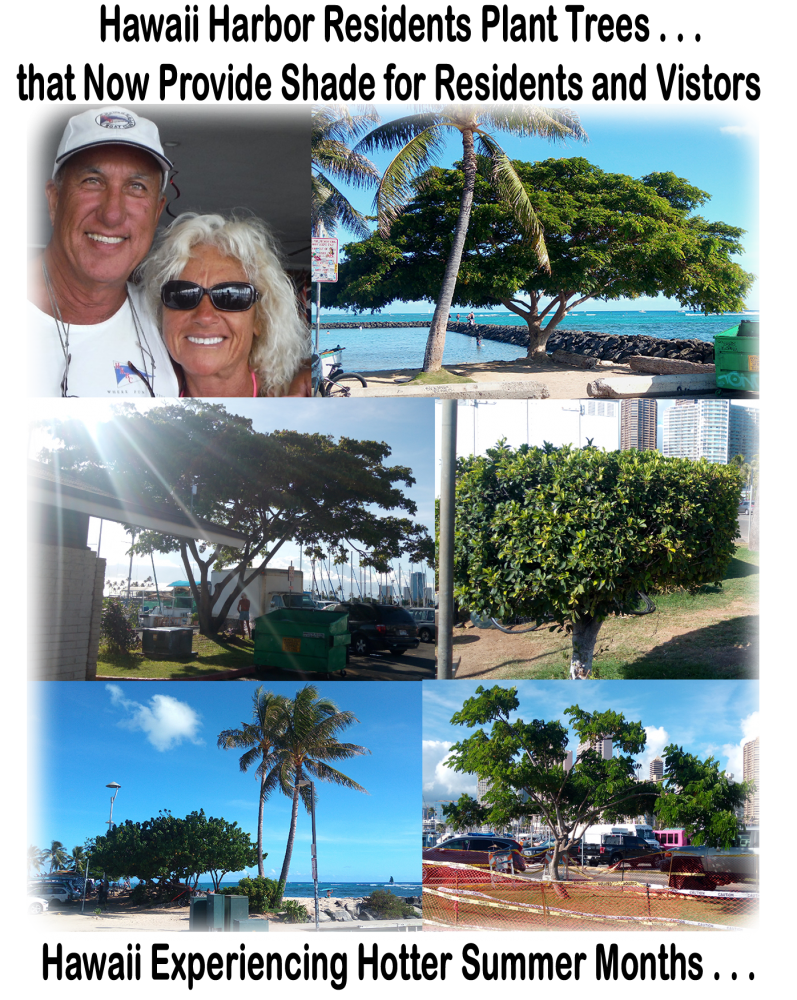Hawaii's Response to Climate Change Warnings Slow - Oahu had it's first ever climate change meeting less than a year ago
Okay, I admit it . . . I’m a weather-report junkie. I guess that comes with the territory; I’m an avid water sports person and weather reports are important, especially when you live in the middle of the Pacific Ocean.
Having said that, my observations of summertime temperatures seem to differ from reports I’m seeing on the Web, suggesting that summer temperatures in Hawaii continue to hover "around 87 degrees F . . . and rarely reach 90 degrees." I suspect that many of these reports are sculpted to help with visitor numbers.
So, by way of correction, via my everyday personal observations of official NOAA weather forecasts: according to NOAA, summertime temperatures in Honolulu (July through mid-October) now regularly hover over 90 degrees F, and that’s every single day.
Hawaii has been my home since my teens. About twenty years ago summertime temperatures in Honolulu hovered around 88 degrees F, every single day. I remember thinking to myself, “. . . always 88 . . . not 87, not 89 . . . but 88 degrees, right on the nose, every single day . . . how is that possible?”
Fast-forward to the 21st century. As I’m writing this, the temperature is 92 degrees F. That’s 92. Not 91, and don’t even think 88. Hawaii's summertime is getting hotter, whether we choose to subscribe to science's climate change warnings, or not.
The Ala Wai Small Boat harbor, in Honolulu, is even hotter, thanks to huge, relatively new high-rise buildings that have been allowed, like the Prince Waikiki, whose reflective windows bounce afternoon heat back onto the harbor, raising temperatures and increasing the discomfort level there. While Rome burns, our politicians continue to fiddle to the tunes dictated by big-money interests, allowing the building of dozens of private mega-structures that block the cooling trade winds and reflect back summer heat. One does wonder if knee-pads have become an official equipment issue at Honolulu Hale, the Capitol building, and the DLNR.
According to ICAP (the Center for Island Climate Adaptation and Policy, based at the University of Hawaii), “[The] data show[s] a rapid rise in air temperature in the past 30 years.” I’m left to wonder if that might account for the 92 degrees that I’m sweltering in right now.
Hawaii residents at the Ala Wai Small Boat Harbor plant shade trees
It’s certainly no secret that our leadership responds slowly –- if at all -- to serious environmental crises in our State. As a result, residents have, for years, adapted by stepping in and volunteering their time, money, expertise and labor to help the community cope with environmental quality of life issues. Examples of volunteer grassroots projects abound -– something that all of us can be proud of -- but, with the warm summer weather upon us, we are reminded of one particular effort by residents at the Ala Wai Small Boat Harbor, in Honolulu. The residents there embarked on a project to plant trees that today provide cool respite for hundreds of beachgoers, visitors, and residents, every single day.
Spearheading the effort, Sam Monet and his partner, Kate, longtime Ala Wai residents, began, years ago, planting trees that had been ripped out by the Harbors Division, all up and down the harbor peninsula that borders the ocean. We've never heard of nor read any plausible explanation for the Harbors Division action.
According to Mr. Monet: “I seeded milo trees and then planted the seedlings along the shoreline, using a black plastic drip line for irrigation. Kate and I started the silk trees from seed, then planted one on the end [of the peninsula], one at the 700-pier bathroom and one more in the small grass area at the shower [by Ala Moana Bowls beach]. My granddad always said, cut one plant two.”
In addition to the seedlings, Mr. Monet and his partner, Kate, planted coconut palms (see pictures in the header) and assorted other trees that, today, beautify the landscape, provide shade from the hot summer sun, and hold the soil in place against erosion.
Kudos to the residents at the Ala Wai for your selfless contributions to the community, and an especially big mahalo -- thank you! -- to Sam and Kate for their amazing foresight and follow-through.
Our Keikis are depending on us to act, now, in responsible and effective ways to prepare for the effects of climate change in the Hawaiian Islands. While it is true that Hawaii was one of the first states to recognize the need for preparing for the future of climate change, implementation of an action plan has, so far, been slow going. Oahu's first meeting on the subject, for example, took place less than a year ago -- a little get-to-know-you affair, flowers on the table, pupus all around, cup of coffee if you wanted it.
This slow start is a bit worrisome because the pattern of activity among rule makers, as of late, seems to have been more focused on finding ways to hand over public lands and assets to private interests, than doing anything to preserve Hawaii for future generations. Air temperatures are on the rise and there are clear signs that our harbor retaining walls can no longer handle larger than normal tides, like they used to, yet, it might be difficult for the current crop of politicians to shift gears. This may be a good time to cull the takers from office, vote them out, and choose people for Hawaii leadership positions who have a demonstrated track record of genuine compassion for our entire community and not just the wealthy who fund campaigns.

